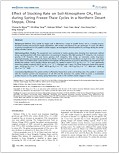| Journal Article |
 |
|
| Article Title | Effect of Stocking Rate on Soil-Atmosphere CH4 Flux during Spring Freeze-Thaw Cycles in a Northern Desert Steppe, China | | Author | Cheng-Jie Wang, Shi-Ming Tang, Andreas Wilkes, Yuan-Yuan Jiang, Guo-Dong Han and Ding Huang | | Year | 2012 | | Journal Title | Plos One | | Institution | Public Library of Science | | Volume | 7 | | Issue | 5 | | Pages | 1-7 | | Call Number | JA0521-14 |
|
| Abstract: |
Background: Methane (CH4) uptake by steppe soils is affected by a range of specific factors and is a complex process.
Increased stocking rate promotes steppe degradation, with unclear consequences for gas exchanges. To assess the effects
of grazing management on CH4 uptake in desert steppes, we investigated soil-atmosphere CH4 exchange during the winterspring
transition period.
Methodology/Main Finding: The experiment was conducted at twelve grazing plots denoting four treatments defined
along a grazing gradient with three replications: non-grazing (0 sheep/ha, NG), light grazing (0.75 sheep/ha, LG), moderate
grazing (1.50 sheep/ha, MG) and heavy grazing (2.25 sheep/ha, HG). Using an automatic cavity ring-down
spectrophotometer, we measured CH4 fluxes from March 1 to April 29 in 2010 and March 2 to April 27 in 2011. According
to the status of soil freeze-thaw cycles (positive and negative soil temperatures occurred in alternation), the experiment was
divided into periods I and II. Results indicate that mean CH4 uptake in period I (7.51 mg CH4–C m22 h21) was significantly
lower than uptake in period II (83.07 mg CH4–C m22 h21). Averaged over 2 years, CH4 fluxes during the freeze-thaw period
were 284.76 mg CH4–C m22 h21 (NG), 288.76 mg CH4–C m22 h21 (LG), 264.77 mg CH4–C m22 h21 (MG) and 228.80 mg
CH4–C m22 h21 (HG).
Conclusions/Significance: CH4 uptake activity is affected by freeze-thaw cycles and stocking rates. CH4 uptake is correlated
with the moisture content and temperature of soil. MG and HG decreases CH4 uptake while LG exerts a considerable
positive impact on CH4 uptake during spring freeze-thaw cycles in the northern desert steppe in China. |
|